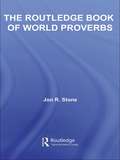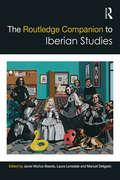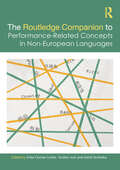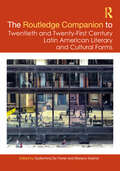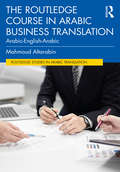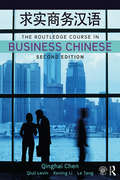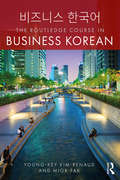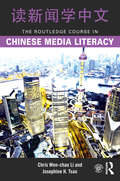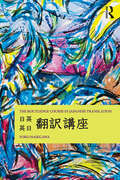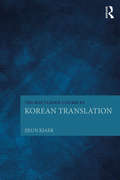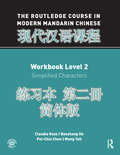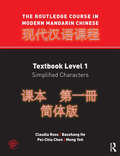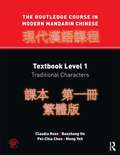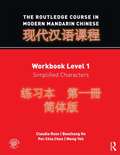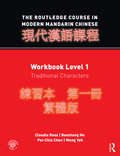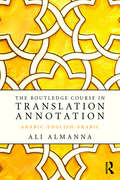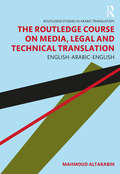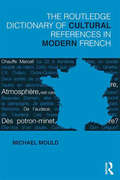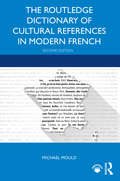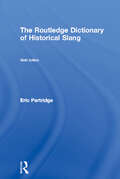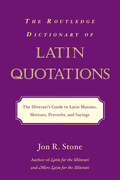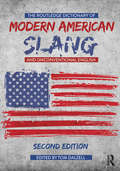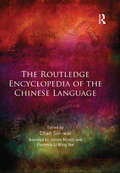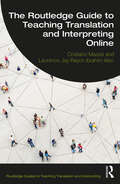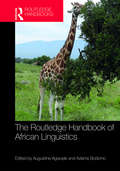- Table View
- List View
The Routledge Book of World Proverbs
by Jon R. StoneThe Routledge Book of World Proverbs invites the reader to travel the globe in search of the origins of such words of wisdom, experiencing the rich cultural traditions reflected in each nation’s proverbs. This collection contains over 16,000 gems of humour and pathos that draw upon themes from our shared experiences of life. And we are not just invited to learn about other cultures; proverbs are ‘bits of ancient wisdom’ and thus teach us about our own history. Drawing together proverbs that transcend culture, time and space to provide a collection that is both useful and enjoyable, The Routledge Book of World Proverbs is, unquestionably, a book of enduring interest.
The Routledge Companion to Iberian Studies
by Javier Muñoz-Basols Laura Lonsdale Manuel Delgado MoralesThis book provides a comprehensive, state-of-the-art account of the field, reaffirming Iberian Studies as a dynamic and evolving discipline offering promising areas of future research. It is an essential tool for research in Iberian Studies.
The Routledge Companion to Performance-Related Concepts in Non-European Languages (ISSN)
by Erika Fischer-Lichte Torsten Jost Astrid SchenkaInvestigating more than 70 key concepts relating to the performing arts in more than six non-European languages, this volume provides a groundbreaking research tool and one-of-a-kind reference source for theatre, performance and dance studies worldwide.The Companion features in-depth explorations of and expert introductions to a select number of performance-related key concepts in Arabic, Chinese, Japanese, Korean, Yorùbá as well as the Indian languages Sanskrit, Hindi and Tamil. Key concepts—such as Furǧa فرجة in Arabic, for example, or Jiadingxing 假定性 in Chinese, Gei 芸 in Japanese, Ìparadà in Yorùbá and Imyeon 이면 in Korean—that defy easy translation from one language to another (and especially into English as the world’s lingua franca) and that reflect culturally specific ways of thinking and talking about the performing arts are thoroughly examined in in-depth articles. Written by more than 60 distinguished scholars from around the globe, the articles describe in detail each concept’s dynamic history, its flexible scope of meaning and current range of usage. The Companion also includes extensive introductions to each language section, in which internationally renowned experts explain how the presented key concepts are situated within, and are constitutive of, distinct and dynamic epistemic systems that have different yet always interlinked histories and orientations. Offers a fascinating insight into the unique histories, characteristics, and orientations of linguistically and culturally distinct epistemic systems related to the performative arts Contains extensive cross-references and bibliographies An invaluable research tool and one-of-a-kind reference source for scholars and students worldwide and across the humanities, especially in the fields of theatre, performance, dance, translation, area and cultural studies An accessible handbook for everybody interested in performance cultures and performance-related knowledge systems existing in the world today. This volume provides an invaluable research tool and one-of-a-kind reference source for scholars and students worldwide and across the humanities, especially in the fields of theatre, performance, dance, translation and area studies, history (of science and the humanities) and cultural studies.
The Routledge Companion to Twentieth and Twenty-First Century Latin American Literary and Cultural Forms (Routledge Companions to Hispanic and Latin American Studies)
by Guillermina De Ferrari Mariano SiskindThe Routledge Companion to Twentieth and Twenty-First Century Latin American Literary and Cultural Forms brings together a team of expert contributors in this critical and innovative volume. Highlighting key trends within the discipline, as well as cutting-edge viewpoints that revise and redefine traditional debates and approaches, readers will come away with an understanding of the complexity of twenty-first-century Latin American cultural production and with a renovated and eminently contemporary understanding of twentieth-century literature and culture. This invaluable resource will be of interest to advanced students and academics in the fields of Latin American literature, cultural studies, and comparative literature.
The Routledge Course in Arabic Business Translation: Arabic-English-Arabic (Routledge Studies in Arabic Translation)
by Mahmoud AltarabinThe Routledge Course in Arabic Business Translation: Arabic-English-Arabic is an essential coursebook for university students wishing to develop their skills in translating different types of business texts between English and Arabic. Practical in its approach, the book introduces translation students to the concept of translation and equivalence in the context of business texts, business translators, and the linguistic and syntactic features of business texts. It also highlights translation tools and technology in addition to the translation strategies which can be adopted to render business texts between English and Arabic. Key features in the book include: • Six comprehensive chapters covering (after the Introduction) the areas of economics, management, production, finance, and marketing in the translation industry; • Detailed explanation of the lexical and syntactic features of business texts; • Practical English and Arabic business translation texts featuring a vast business vocabulary bank; • Authentic business texts extracted from English and Arabic books containing economic, management, production, finance, and marketing texts; • Great range of English and Arabic translation exercises to enable students to practice their familiarity with business vocabulary they learned throughout the book; and • Glossaries following all English and Arabic business texts containing the translation of main vocabulary items. The practicality of the approach adopted in this book makes it an essential business translation coursebook for translation students. In addition, the carefully designed content helps students to easily explore different types of business texts, familiarize themselves with main words, and do translation exercises. University instructors working on English and Arabic business translations will find this book highly useful.
The Routledge Course in Business Chinese
by Qinghai Chen Qiuli Levin Kening Li Le Tang• Fourth-year language learning or above in preparation for real-life business situations各专业学生汉语四年级(或以上)适用 • Timeless business topics ranging from frequently occurring business activities, economic systems and phenomena, to issues of broad interest使用通用商务题材确保教材长期相对稳定 • Simulated real-world tasks connecting the classroom to China’s current economic developments through students’ own efforts组织大量以学生为主体的任务型实践活动 ,实现题材即时更新 • A focus on formal language style and business terminology 注重正式语体和专业词语的学习 • Summary of important features of Chinese with emphasis on language learning skills to cultivate self-sustained and effective language learners 归纳汉语基本特点,教授学习方法,培养自学能力
The Routledge Course in Business Korean
by Young-Key Kim-Renaud Miok PakThe Routledge Course in Business Korean is a textbook to teach Korean to mid-intermediate to low-advanced students learning the language used in a business context in every-day life in Korea. The authors’ intuitive approach makes it easy for students to follow the units, while the relevant and practical learning objectives benefit both student and teacher alike. The book introduces the vocabulary and key phrases of Business Korean and focuses on delivering real business-related situations, authentic expressions, and linguistically and culturally rich introductions and explanations of Korean business life. Audio files can be found on the accompanying e-Resource. By the end of this course, you will be at level B2 of the Common European Framework for Languages and Advanced Mid-High on the ACTFL proficiency scales.
The Routledge Course in Chinese Media Literacy
by Chris Wen-chao Li Josephine H. TsaoThe Routledge Course in Chinese Media Literacy is aimed at lower advanced level students of Mandarin who wish to build media literacy in the Chinese language. The book is written by university professors who have hands-on experience as media professionals. It gathers newsworthy authentic materials on topics covered by reporters on a day-to-day basis, and makes them accessible through prereading exercises, grammatical analysis, vocabulary associations, and research training for language learners. From front page headlines to business, education, crime, and sports and entertainment, the student reader will be exposed to the full scope of news coverage and become familiar with their presentation in a Chinese context. A companion website with audio, video, accompanying materials and a traditional Chinese edition is available at www.routledge.com/cw/li.
The Routledge Course in Japanese Translation
by Yoko HasegawaThe Routledge Course in Japanese Translation brings together for the first time material dedicated to the theory and practice of translation to and from Japanese. This one semester advanced course in Japanese translation is designed to raise awareness of the many considerations that must be taken into account when translating a text. As students progress through the course they will acquire various tools to deal with the common problems typically involved in the practice of translation. Particular attention is paid to the structural differences between Japanese and English and to cross-cultural dissimilarities in stylistics. Essential theory and information on the translation process are provided as well as abundant practical tasks. The Routledge Course in Japanese Translation is essential reading for all serious students of Japanese at both undergraduate and postgraduate level.
The Routledge Course in Korean Translation
by Jieun KiaerThe Routledge Course in Korean Translation brings together for the first time materials dedicated to the theory and practice of translation to and from Korean. This advanced course in Korean translation discusses cross-linguistic and cross-cultural issues that arise in the course of Korean-English and English-Korean translation and offers useful tools for dealing with the problems that arise in the actual practice of translation. Equipped with examples from a range of genres, this book provides a foundational understanding in translation theory that is necessary in Korean translation. The Routledge Course in Korean Translation is essential reading for students of Korean at both undergraduate and postgraduate levels interested in translation, as well as for students and researchers with knowledge of Korean who are interested in linguistics, and cultural and comunication studies.
The Routledge Course in Modern Mandarin Chinese Workbook Level 2 (Simplified)
by Claudia Ross Baozhang He Pei-Chia Chen Meng YehThe Routledge Course in Mandarin Chinese is a two-year undergraduate course for students with no prior background in Chinese study. Designed to build a strong foundation in both the spoken and written language it develops all the basic skills such as pronunciation, character writing, word use and structures, while placing strong emphasis on the development of communicative skills. The complete course consists of Textbook Level 1, Workbook Level 1 – including free CDs, Textbook level 2 and workbook Level 2 – including free CDs. All books are available separately in simplified as well as traditional characters and take the students from complete beginner to post-intermediate level. Workbook Level 2 is designed to accompany Textbook Level 2 lesson by lesson, and offers exercises for homework, independent study and classroom use. The exercises focus on interpersonal, interpretative and presentational modes of communication while helping students to consolidate the vocabulary, characters, and structures introduced in each lesson. At the conclusion of this course, students will be able to read page-length texts for information, listen to and comprehend extended narratives on a variety of topics, and communicate a broad range of information orally and in writing. The course is also fully supported by an interactive companion website which contains a wealth of additional resources for both teachers and students. Teachers will find lesson plans in both English and Mandarin, providing a weekly schedule and overall syllabus for fall and spring, as well as activities for each lesson and answer keys. Students will be able to access downloadable character practice worksheets along with interactive pronunciation, vocabulary and character practice exercises. All the audio material necessary for the course is also available online and conveniently linked on screen to the relevant exercises for ease-of-use. For more information about the course and to access these additional resources, please visit the Companion Website at www.routledge.com/textbooks/9780415472517 For bundle discounts please visit: For bundle discounts please visit: http://www.routledge.com/books/details/9780415533072/ ?
The Routledge Course in Modern Mandarin Chinese: Textbook Level 1, Simplified Characters
by Claudia Ross Baozhang He Pei-Chia Chen Meng YehThe Routledge Course in Modern Mandarin Chinese is a two-year undergraduate course for students with no prior background in Chinese study which takes students from complete beginner to post-intermediate level. Designed to build a strong foundation in both the spoken and written language it develops all the basic skills such as pronunciation, character writing, word use and structures, while placing strong emphasis on the development of communicative skills. Each level of the course consists of a textbook and workbook, available separately in simplified or traditional character editions. Both workbooks include a free CD with all the dialogues from the textbooks and the necessary audio for the listening for information exercises. A companion website will provide expanded listening files and a broad range of resources for students and teachers. The benefits of this course include: focus on the long-term retention of vocabulary, characters and structures by reiterating structures and vocabulary throughout the book series carefully selected and staged introduction of characters with staged removal of pinyin to ensure recognition and use of characters clear and jargon-free explanations of use and structures, that are easy for students and teachers to understand extensive workbook exercises for homework, independent study, and classroom use focusing on all language skills and modalities including a vast inventory of carefully structured exercises focusing on listening comprehension, reading for information, and writing for communication an extensive inventory of classroom activities that guide students to develop a list of communication goals and key structures for each lesson allowing the student to assess progress cultural notes explaining the context of the dialogues language FAQs explaining aspects of Chinese language as they relate to the content and vocabulary in the lesson storyline following a group of students studying in China from Europe, North America and East Asia, making the book attractive to a variety of students and facilitating the introduction of Chinese culture full-color text design for the textbook and carefully matched designs for the traditional and simplified books, allowing for easy cross-reference. The course is also fully supported by an interactive Companion Website. The website contains a wealth of additional resources for both teachers and students. Teachers will find lesson plans in both English and Mandarin, providing a weekly schedule and overall syllabus for fall and spring, as well as activities for each lesson and answer keys. Students will be able to access downloadable character practice worksheets along with interactive pronunciation, vocabulary and character practice exercises. All the audio material necessary for the course is also available online and conveniently linked on screen to the relevant exercises for ease-of-use. For further details please visit http://www.routledge.com/books/details/9780415472517/ For bundle discounts please visit http://www.routledge.com/books/details/9780415596824/
The Routledge Course in Modern Mandarin Chinese: Textbook Level 1, Traditional Characters
by Claudia Ross Baozhang He Pei-Chia Chen Meng YehThe Routledge Course in Modern Mandarin Chinese is a two-year undergraduate course for students with no prior background in Chinese study which takes students from complete beginner to post-intermediate level. Designed to build a strong foundation in both the spoken and written language it develops all the basic skills such as pronunciation, character writing, word use and structures, while placing strong emphasis on the development of communicative skills. Each level of the course consists of a textbook and workbook, available separately in simplified or traditional character editions. Both workbooks include a free CD with all the dialogues from the textbooks and the necessary audio for the listening for information exercises. A companion website will provide expanded listening files and a broad range of resources for students and teachers. The benefits of this course include: -focus on the long-term retention of vocabulary, characters and structures by reiterating structures and vocabulary throughout the book series -carefully selected and staged introduction of characters with staged removal of pinyin to ensure recognition and use of characters -clear and jargon-free explanations of use and structures, that are easy for students and teachers to understand -extensive workbook exercises for homework, independent study, and classroom use focusing on all language skills and modalities including a vast inventory of carefully structured exercises focusing on listening comprehension, reading for information, and writing for communication - an extensive inventory of classroom activities that guide students to develop communication-based speaking and listening skills. -a list of communication goals and key structures for each lesson allowing the student to assess progress -cultural notes explaining the context of the dialogues - language FAQs explaining aspects of Chinese language as they relate to the content and vocabulary in the lesson -storyline following a group of students studying in China from Europe, North America and East Asia, making the book attractive to a variety of students and facilitating the introduction of Chinese culture. -full-color text design for the textbook and carefully matched designs for the traditional and simplified books, allowing for easy cross-reference The course is also fully supported by an interactive companion website. The website contains a wealth of additional resources for both teachers and students. Teachers will find lesson plans in both English and Mandarin, providing a weekly schedule and overall syllabus for fall and spring, as well as activities for each lesson and answer keys. Students will be able to access downloadable character practice worksheets along with interactive pronunciation, vocabulary and character practice exercises. All the audio material necessary for the course is also available onliine and conveniently linked on screen to the relevant exercises for ease-of-use. For further details please visit http://www.routledge.com/books/details/9780415472517/ For bundle discounts please visit http://www.routledge.com/books/details/9780415596862/
The Routledge Course in Modern Mandarin Chinese: Workbook Level 1, Simplified Characters
by Claudia Ross Baozhang He Pei-Chia Chen Meng YehThe Routledge Course in Modern Mandarin Chinese is a two-year undergraduate course for students with no prior background in Chinese study which takes students from complete beginner to post-intermediate level. Designed to build a strong foundation in both the spoken and written language it develops all the basic skills such as pronunciation, character writing, word use and structures, while placing strong emphasis on the development of communicative skills. Each level of the course consists of a textbook and workbook, available separately in simplified or traditional character editions. Both workbooks include a free CD with all the dialogues from the textbooks and the necessary audio for the listening for information exercises. A companion website will provide expanded listening files and a broad range of resources for students and teachers. The benefits of this course include: -focus on the long-term retention of vocabulary, characters and structures by reiterating structures and vocabulary throughout the book series -carefully selected and staged introduction of characters with staged removal of pinyin to ensure recognition and use of characters -clear and jargon-free explanations of use and structures, that are easy for students and teachers to understand -extensive workbook exercises for homework, independent study, and classroom use focusing on all language skills and modalities including a vast inventory of carefully structured exercises focusing on listening comprehension, reading for information, and writing for communication - an extensive inventory of classroom activities that guide students to develop communication-based speaking and listening skills. -a list of communication goals and key structures for each lesson allowing the student to assess progress -cultural notes explaining the context of the dialogues - language FAQs explaining aspects of Chinese language as they relate to the content and vocabulary in the lesson -storyline following a group of students studying in China from Europe, North America and East Asia, making the book attractive to a variety of students and facilitating the introduction of Chinese culture. -full-color text design for the textbook and carefully matched designs for the traditional and simplified books, allowing for easy cross-reference The course is also fully supported by an interactive companion website. The website contains a wealth of additional resources for both teachers and students. Teachers will find lesson plans in both English and Mandarin, providing a weekly schedule and overall syllabus for fall and spring, as well as activities for each lesson and answer keys. Students will be able to access downloadable character practice worksheets along with interactive pronunciation, vocabulary and character practice exercises. All the audio material necessary for the course is also available online and conveniently linked on screen to the relevant exercises for ease-of-use. For further details please visit http://www.routledge.com/books/details/9780415472517/ For bundle discounts please visit http://www.routledge.com/books/details/9780415596824/
The Routledge Course in Modern Mandarin Chinese: Workbook Level 1, Traditional Characters
by Claudia Ross Baozhang He Pei-Chia Chen Meng YehThe Routledge Course in Modern Mandarin Chinese is a two-year undergraduate course for students with no prior background in Chinese study which takes students from complete beginner to post-intermediate level. Designed to build a strong foundation in both the spoken and written language it develops all the basic skills such as pronunciation, character writing, word use and structures, while placing strong emphasis on the development of communicative skills. Each level of the course consists of a textbook and workbook, available separately in simplified or traditional character editions. Both workbooks include a free CD with all the dialogues from the textbooks and the necessary audio for the listening for information exercises. A companion website will provide expanded listening files and a broad range of resources for students and teachers. The benefits of this course include: -focus on the long-term retention of vocabulary, characters and structures by reiterating structures and vocabulary throughout the book series -carefully selected and staged introduction of characters with staged removal of pinyin to ensure recognition and use of characters -clear and jargon-free explanations of use and structures, that are easy for students and teachers to understand -extensive workbook exercises for homework, independent study, and classroom use focusing on all language skills and modalities including a vast inventory of carefully structured exercises focusing on listening comprehension, reading for information, and writing for communication - an extensive inventory of classroom activities that guide students to develop communication-based speaking and listening skills. -a list of communication goals and key structures for each lesson allowing the student to assess progress -cultural notes explaining the context of the dialogues - language FAQs explaining aspects of Chinese language as they relate to the content and vocabulary in the lesson -storyline following a group of students studying in China from Europe, North America and East Asia, making the book attractive to a variety of students and facilitating the introduction of Chinese culture. -full-color text design for the textbook and carefully matched designs for the traditional and simplified books, allowing for easy cross-reference. The course is also fully supported by an interactive companion website. The website contains a wealth of additional resources for both teachers and students. Teachers will find lesson plans in both English and Mandarin, providing a weekly schedule and overall syllabus for fall and spring, as well as activities for each lesson and answer keys. Students will be able to access downloadable character practice worksheets along with interactive pronunciation, vocabulary and character practice exercises. All the audio material necessary for the course is also available onliine and conveniently linked on screen to the relevant exercises for ease-of-use. For further details please visit http://www.routledge.com/books/details/9780415472517/ For bundle discounts please visit http://www.routledge.com/books/details/9780415596862/
The Routledge Course in Translation Annotation: Arabic-English-Arabic
by Ali AlmannaThe Routledge Course in Translation Annotation: Arabic-English-Arabic is a key coursebook for students and practitioners of translation studies. Focusing on one of the most prominent developments in translation studies, annotation for translation purposes, it provides the reader with the theoretical framework for annotating their own, or commenting on others', translations. The book: presents a systematic and thorough explanation of translation strategies, supported throughout by bi-directional examples from and into English features authentic materials taken from a wide range of sources, including literary, journalistic, religious, legal, technical and commercial texts brings the theory and practice of translation annotation together in an informed and comprehensive way includes practical exercises at the end of each chapter to consolidate learning and allow the reader to put the theory into practice culminates with a long annotated literary text, allowing the reader to have a clear vision on how to apply the theoretical elements in a cohesive way The Routledge Course in Translation Annotation is an essential text for both undergraduate and postgraduate students of Arabic-English translation and of translation studies.
The Routledge Course on Media, Legal and Technical Translation: English-Arabic-English (Routledge Studies in Arabic Translation)
by Mahmoud AltarabinThe Routledge Course on Media, Legal and Technical Translation: English-Arabic-English is an indispensable and engaging coursebook for university students wishing to develop their English-Arabic-English translation skills in these three text types. Taking a practical approach, the book introduces Arab translation students to common translation strategies in addition to the linguistic, syntactic, and stylistic features of media, legal, and technical texts. This book features texts carefully selected for their technical relevance. The key features include: • comprehensive four chapters covering media, legal, and technical texts, which are of immense importance to Arab translation students; • detailed and clear explanations of the lexical, syntactic, and stylistic features of English and Arabic media, legal, and technical texts; • up-to-date and practical translation examples in both directions offering students actual experiences of professional translators; • authentic texts extracted from various sources to promote students’ familiarity with language features and use; • extensive range of exercises following each section of the book to enable students to test and practice the knowledge and skills they developed from reading previous sections; • glossaries following most exercises containing the translation of difficult words; and • a list of recommended readings following each chapter. The easy, practical, and comprehensive approach adopted in the book makes it a must-have coursebook for intermediate and advanced students studying translation between English and Arabic. University instructors and professional translators working on translation between English and Arabic will find this book particularly useful.
The Routledge Dictionary of Cultural References in Modern French
by Michael MouldThe Routledge Dictionary of Cultural References in Modern French reveals the hidden cultural dimension of contemporary French, as used in the press, going beyond the limited and purely lexical approach of traditional bilingual dictionaries. Even foreign learners of French who possess a good level of French often have difficulty in fully understanding French articles, not because of any linguistic shortcomings on their part but because of their inadequate knowledge of the cultural references. This cultural dictionary of French provides the reader with clear and concise explanations of the crucial cultural dimension behind the most frequently used words and phrases found in the contemporary French press. This vital background information, gathered here in this innovative and entertaining dictionary, will allow readers to go beyond a superficial understanding of the French press and the French language in general, to see the hidden yet implied cultural significance that is so transparent to the native speaker. Key features: a broad range of cultural references from the historical and literary to the popular and classical, with an in-depth analysis of punning mechanisms. over 3,000 cultural references explained a three-level indicator of frequency over 600 questions to test knowledge before and after reading. The Routledge Dictionary of Cultural References in Modern French is the ideal reference for all undergraduate and postgraduate students of French seeking to enhance their understanding of the French language. It will also be of interest to teachers, translators and Francophiles alike. French students in khâgne, Sciences-Po and schools of journalism will also find this valuable and relevant for their studies.
The Routledge Dictionary of Cultural References in Modern French
by Michael MouldNow in its second edition, The Routledge Dictionary of Cultural References in Modern French reveals the hidden cultural dimension of contemporary French, as used in the press, going beyond the limited and purely lexical approach of traditional bilingual dictionaries. Even foreign learners of French who possess a good level of French often have difficulty in fully understanding French articles, not because of any linguistic shortcomings on their part but because of their inadequate knowledge of the cultural references. This cultural dictionary of French provides the reader with clear and concise explanations of the crucial cultural dimension behind the most frequently used words and phrases found in the contemporary French press. This vital background information, gathered here in this innovative and entertaining dictionary, will allow readers to go beyond a superficial understanding of the French press and the French language in general to see the hidden yet implied cultural significance that is so transparent to the native speaker. This fully revised second edition includes: a broad range of cultural references from the historical and literary to the popular and classical; an enhanced analysis of punning mechanisms used in the press; over 3,000 cultural references explained with updated examples; a three-level indicator of frequency; new and expanded chapters on the French of Quebec, institutional and academic references, and English borrowings in the areas of IT and medical science; over 600 online questions to test knowledge before and after reading. The Routledge Dictionary of Cultural References in Modern French is the ideal reference for all undergraduate and postgraduate students of French seeking to enhance their understanding of the French language. It will also be of interest to teachers, translators and Francophiles alike. French students in khâgne, Sciences-Po and schools of journalism will also find this book valuable and relevant for their studies. Test questions and solutions are available at www.routledge.com/9780367376758, in addition to three online chapters. These bonus chapters explore figurative expressions involving the names of animals, the language of the law and slang terms.
The Routledge Dictionary of Historical Slang
by Eric PartridgeDrawn from the Dictionary of Slang and Unconventional English, with the emphasis on the expressions used or coined before 1914.
The Routledge Dictionary of Latin Quotations: The Illiterati's Guide to Latin Maxims, Mottoes, Proverbs, and Sayings
by Jon R. StoneThe Routledge Dictionary of Latin Quotations completes our enormously successful and award-winning Latin for the Illiterati series of volumes, rounding off the trilogy with a comprehensive treasury of classic Latin quotations, mottoes, proverbs, and maxims collected from the worlds of philosophy, rhetoric, politics, science, religion, literature, drama, poetics, and war.Distinguished by the combination of user-friendliness and comprehensiveness, this book will provide students, scholars, and general readers with an eminently browsable resource that is as useful as it is enjoyable.
The Routledge Dictionary of Modern American Slang and Unconventional English
by Tom DalzellThe Routledge Dictionary of Modern American Slang offers the ultimate record of modern, post WW2 American Slang. The 25,000 entries are accompanied by citations that authenticate the words as well as offer examples of usage from popular literature, newspapers, magazines, movies, television shows, musical lyrics, and Internet user groups. Etymology, cultural context, country of origin and the date the word was first used are also provided. In terms of content, the cultural transformations since 1945 are astounding. Television, computers, drugs, music, unpopular wars, youth movements, changing racial sensitivities and attitudes towards sex and sexuality are all substantial factors that have shaped culture and language. This new edition includes over 500 new headwords collected with citations from the last five years, a period of immense change in the English language, as well as revised existing entries with new dating and citations. No term is excluded on the grounds that it might be considered offensive as a racial, ethnic, religious, sexual or any kind of slur. This dictionary contains many entries and citations that will, and should, offend. Rich, scholarly and informative, The Routledge Dictionary of Modern American Slang and Unconventional English is an indispensable resource for language researchers, lexicographers and translators.
The Routledge Encyclopedia of the Chinese Language
by Sin-Wai ChanThe Routledge Encyclopedia of the Chinese Language is an invaluable resource for language learners and linguists of Chinese worldwide, those interested readers of Chinese literature and cultures, and scholars in Chinese studies. Featuring the research on the changing landscape of the Chinese language by a number of eminent academics in the field, this volume will meet the academic, linguistic and pedagogical needs of anyone interested in the Chinese language: from Sinologists to Chinese linguists, as well as teachers and learners of Chinese as a second language. The encyclopedia explores a range of topics: from research on oracle bone and bronze inscriptions, to Chinese language acquisition, to the language of the mass media. This reference offers a guide to shifts over time in thinking about the Chinese language as well as providing an overview of contemporary themes, debates and research interests. The editors and contributors are assisted by an editorial board comprised of the best and most experienced sinologists world-wide. The reference includes an introduction, written by the editor, which places the assembled texts in their historical and intellectual context. The Encyclopedia of the Chinese Language is destined to be valued by scholars and students as a vital research resource.
The Routledge Guide to Teaching Translation and Interpreting Online (Routledge Guides to Teaching Translation and Interpreting)
by Cristiano Mazzei Laurence Jay-Rayon Ibrahim AiboRoutledge Guides to Teaching Translation and Interpreting is a series of practical guides to key areas of translation and interpreting for instructors, lecturers, and course designers. The Routledge Guide to Teaching Translation and Interpreting Online is for educators of translation and interpreting teaching online in a variety of curricular combinations: fully online, partially online, hybrid, multimodal, or face-to-face with online components. Offering suggestions for the development of curriculum and course design in addition to online tools that can be used in skill-building activities, and adaptable to specific instructional needs, this textbook is suitable for both multilingual and language-specific classes. Fully comprehensive, the book addresses the tenets and importance of process-oriented pedagogy for students of translation and interpreting, best practices in online curriculum and course design, instructor online presence, detailed illustrations of specific online assignments, the importance of regular and timely feedback, and teaching across the online translation and interpreting (T&I) curriculum. Written by two experienced translators, interpreters, and scholars who have been teaching online for many years and in various settings, this book is an essential guide for all instructors of translation and interpreting as professional activities and academic disciplines.
The Routledge Handbook of African Linguistics (Routledge Language Handbooks)
by Augustine Agwuele Adams BodomoThe Handbook of African Linguistics provides a holistic coverage of the key themes, subfields, approaches and practical application to the vast areas subsumable under African linguistics that will serve researchers working across the wide continuum in the field. Established and emerging scholars of African languages who are active and current in their fields are brought together, each making use of data from a linguistic group in Africa to explicate a chosen theme within their area of expertise, and illustrate the practice of the discipline in the continent.
